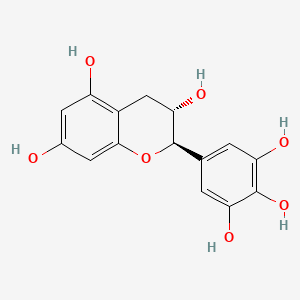| MeSH term | MeSH ID | Detail |
|---|---|---|
| Hemolysis | D006461 | 131 associated lipids |
| Adenocarcinoma | D000230 | 166 associated lipids |
| Lung Neoplasms | D008175 | 171 associated lipids |
| Reperfusion Injury | D015427 | 65 associated lipids |
| Colonic Neoplasms | D003110 | 161 associated lipids |
| Sarcoma 180 | D012510 | 21 associated lipids |
| Body Weight | D001835 | 333 associated lipids |
| Edema | D004487 | 152 associated lipids |
| Precancerous Conditions | D011230 | 48 associated lipids |
| Liver Diseases | D008107 | 31 associated lipids |
Gallocatechin
(+)-gallocatechin is a lipid of Polyketides (PK) class. The involved functions are known as inhibitors and Cell Survival. The associated genes with (+)-Gallocatechin are TERT gene.
Cross Reference
Introduction
To understand associated biological information of Gallocatechin, we collected biological information of abnormalities, associated pathways, cellular/molecular locations, biological functions, related genes/proteins, lipids and common seen animal/experimental models with organized paragraphs from literatures.
What diseases are associated with Gallocatechin?
Gallocatechin is suspected in Hyperinsulinism, nervous system disorder, Obesity, Parkinson Disease, Transient ischemia and other diseases in descending order of the highest number of associated sentences.
Related references are mostly published in these journals:
| Disease | Cross reference | Weighted score | Related literature |
|---|
Possible diseases from mapped MeSH terms on references
We collected disease MeSH terms mapped to the references associated with Gallocatechin
PubChem Associated disorders and diseases
What pathways are associated with Gallocatechin
There are no associated biomedical information in the current reference collection.
PubChem Biomolecular Interactions and Pathways
Link to PubChem Biomolecular Interactions and PathwaysWhat cellular locations are associated with Gallocatechin?
Visualization in cellular structure
Associated locations are in red color. Not associated locations are in black.
Related references are published most in these journals:
| Location | Cross reference | Weighted score | Related literatures |
|---|
What functions are associated with Gallocatechin?
Related references are published most in these journals:
| Function | Cross reference | Weighted score | Related literatures |
|---|
What lipids are associated with Gallocatechin?
Related references are published most in these journals:
| Lipid concept | Cross reference | Weighted score | Related literatures |
|---|
What genes are associated with Gallocatechin?
Related references are published most in these journals:
- Drug Metab. Dispos. (4)
- Cancer Epidemiol. Biomarkers Prev. (2)
- Am. J. Physiol., Cell Physiol. (1)
- Others (7)
| Gene | Cross reference | Weighted score | Related literatures |
|---|
What common seen animal models are associated with Gallocatechin?
Transgenic Model
Transgenic Model are used in the study 'Dietary (-)-epicatechin as a potent inhibitor of βγ-secretase amyloid precursor protein processing.' (Cox CJ et al., 2015).
Rodent Model
Rodent Model are used in the study 'Dietary (-)-epicatechin as a potent inhibitor of βγ-secretase amyloid precursor protein processing.' (Cox CJ et al., 2015).
Related references are published most in these journals:
| Model | Cross reference | Weighted score | Related literatures |
|---|
NCBI Entrez Crosslinks
All references with Gallocatechin
Download all related citations| Authors | Title | Published | Journal | PubMed Link |
|---|---|---|---|---|
| Fang R et al. | Variation of theanine, phenolic, and methylxanthine compounds in 21 cultivars of Camellia sinensis harvested in different seasons. | 2017 | Food Chem | pmid:27855934 |
| Miyauchi S et al. | Quality evaluation of green tea leaf cultured under artificial light condition using gas chromatography/mass spectrometry. | 2017 | J. Biosci. Bioeng. | pmid:27568369 |
| Yin Y et al. | Cell surface GRP78 facilitates hepatoma cells proliferation and migration by activating IGF-IR. | 2017 | Cell. Signal. | pmid:28389416 |
| Fechtner S et al. | Molecular insights into the differences in anti-inflammatory activities of green tea catechins on IL-1β signaling in rheumatoid arthritis synovial fibroblasts. | 2017 | Toxicol. Appl. Pharmacol. | pmid:28532672 |
| Bałan BJ et al. | Morphometric abnormalities in the spleen of the progeny of mice fed epigallocatechin during gestation and nursing. | 2017 | Pol J Vet Sci | pmid:28525335 |
| Liang J et al. | Encapsulation of epigallocatechin gallate in zein/chitosan nanoparticles for controlled applications in food systems. | 2017 | Food Chem | pmid:28449996 |
| Zinellu A et al. | N- and S-homocysteinylation reduce the binding of human serum albumin to catechins. | 2017 | Eur J Nutr | pmid:26658763 |
| Kong LX and Zeng CM | Effects of Seeding on Lysozyme Amyloid Fibrillation in the Presence of Epigallocatechin and Polyethylene Glycol. | 2017 | Biochemistry Mosc. | pmid:28320299 |
| Xia G et al. | Tannase-mediated biotransformation assisted separation and purification of theaflavin and epigallocatechin by high speed counter current chromatography and preparative high performance liquid chromatography: A comparative study. | 2016 | Microsc. Res. Tech. | pmid:27389804 |
| Fan FY et al. | Differential behaviors of tea catechins under thermal processing: Formation of non-enzymatic oligomers. | 2016 | Food Chem | pmid:26593500 |
